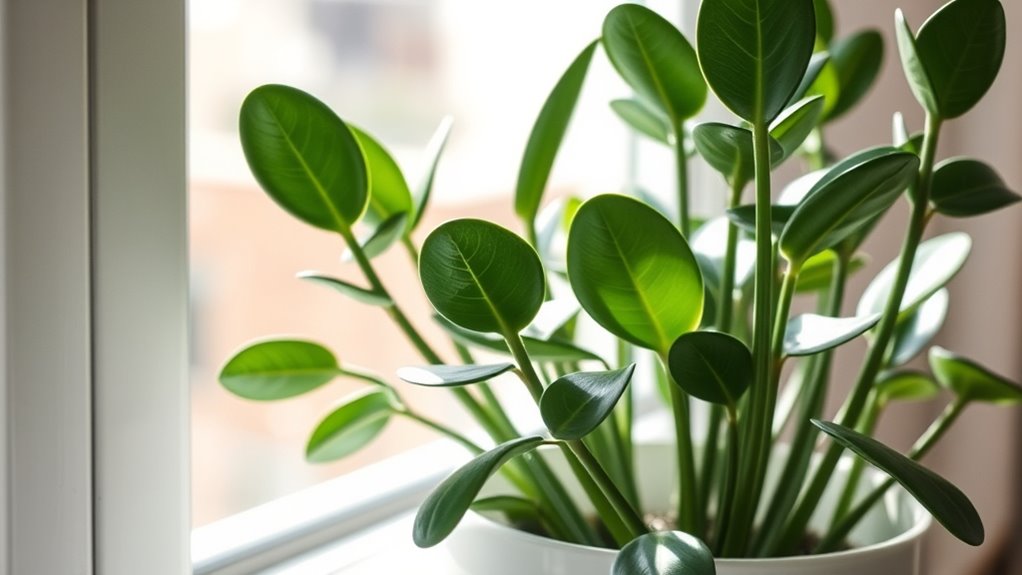To care for your ZZ plant, remember it’s drought-tolerant, so let the soil dry completely between waterings—typically every 3-4 weeks in spring and summer, and longer in winter. Use well-draining soil and make certain your pot has drainage holes to prevent overwatering. Regular pruning keeps it healthy and shapely. By understanding these basics, you’ll keep your ZZ thriving; continue for more tips to maintain your plant’s vigor and beauty.
Key Takeaways
- Allow the soil to dry completely between waterings; water every 3-4 weeks in spring/summer and less in winter.
- Use well-draining soil and pots with drainage holes to prevent water buildup and root rot.
- Water thoroughly when the top inch of soil feels dry, ensuring excess water drains out.
- ZZ plants thrive with infrequent watering, making them ideal for drought-tolerant, low-maintenance care.
- Avoid overwatering; they are drought-tolerant and prefer dry conditions to stay healthy and vibrant.

The ZZ plant, known for its striking, glossy leaves and low-maintenance nature, is a popular choice for both beginners and experienced plant enthusiasts. Its resilience makes it perfect for busy schedules or forgetful watering habits. When caring for your ZZ plant, one of the most important factors is establishing a proper watering schedule. Unlike many houseplants, the ZZ prefers to be drought-tolerant, so you should let the soil dry out completely between waterings. Overwatering can lead to root rot, which is a common issue with these plants. During the growing season, usually spring and summer, you might water every three to four weeks, but in winter, you can extend that to every six weeks or more. Always check the top inch of soil; if it feels dry, it’s time to water. When you do water, give enough so that excess drains out of the pot’s bottom, ensuring the roots don’t sit in water. Using a well-draining potting mix and a pot with drainage holes further helps prevent overwatering. Consistent attention to your watering schedule will keep your ZZ healthy and vibrant. Additionally, understanding soil drainage and its impact on plant health can help you optimize your care routine. Pruning techniques are equally straightforward but essential for maintaining your plant’s shape and health. The ZZ plant naturally grows upright with thick, waxy stems, and pruning helps control its size and encourages bushier growth. When pruning, use clean, sharp scissors or pruning shears to avoid damaging the plant. Remove any yellow or damaged leaves at the base, cutting close to the stem. If you notice stems that are overly tall or leggy, trim them back to encourage new growth lower down. Don’t be afraid to prune heavily if needed; the ZZ tends to recover quickly. Regular pruning also allows you to remove any dead or unhealthy parts, which can prevent pest issues and diseases. You can also prune to shape the plant or to propagate new plants. Just make sure to leave some healthy foliage on each stem, as the ZZ relies on its leaves for photosynthesis. After pruning, you might notice new shoots emerging from the cut points, which will fill out your plant over time.
Frequently Asked Questions
Can ZZ Plants Survive in Low Light Conditions Long-Term?
Yes, ZZ plants can survive long-term in low light conditions because they have excellent low light tolerance. You might notice slower growth or less vibrant leaves, but they won’t die quickly. To guarantee their health, rotate them occasionally to prevent legginess and avoid overwatering. With proper care, your ZZ plant will thrive even in dim spaces, making it a perfect choice for low-light areas in your home or office.
How Often Should I Water My ZZ Plant During Winter?
During winter, you should water your ZZ plant only when the top inch of soil feels bone dry—that’s usually every 3 to 4 weeks! Don’t drown it with extra winter moisture; overwatering can turn your drought-tolerant hero into a soggy mess. Stick to a careful watering schedule, and your ZZ plant will thrive happily through the cold months, needing just enough water to stay healthy without drowning.
What Are Common Pests That Affect ZZ Plants?
You should watch for common pests like spider mites, mealybugs, and scale insects that can affect your ZZ plant. To prevent pests, regularly inspect your plant and keep its environment clean. Use natural remedies like neem oil or insecticidal soap at the first sign of trouble. Good pest prevention helps your ZZ plant stay healthy, vibrant, and free from infestations that could cause damage.
Is It Safe to Have ZZ Plants Around Pets?
You might think ZZ plants are safe around pets, but they’re actually toxic plants. It’s important to prioritize pet safety because ingesting parts of the ZZ plant can cause symptoms like nausea, vomiting, and even more serious issues. To keep your furry friends safe, it’s best to keep ZZ plants out of reach or consider pet-friendly alternatives. Always verify plant safety to prevent accidental poisoning.
How Can I Propagate My ZZ Plant Successfully?
To propagate your ZZ plant successfully, start by using clean propagation tools to carefully separate healthy stems or roots. Mix well-draining soil with perlite or sand to create the right environment, then plant the cuttings into this soil. Keep the soil lightly moist and place the new plants in bright, indirect light. With patience, your ZZ plant will develop new roots and grow into a thriving houseplant.
Conclusion
With proper care, your ZZ plant will thrive like a quiet fortress, resilient and steadfast in any space. Its drought-tolerant nature makes it a low-maintenance companion that brings lush greenery without fuss. Think of it as a calming oasis amid life’s chaos, quietly anchoring your home with its elegant presence. Keep to the basics, and your ZZ plant will reward you with vibrant, enduring beauty—truly a steadfast sentinel in your indoor garden.









